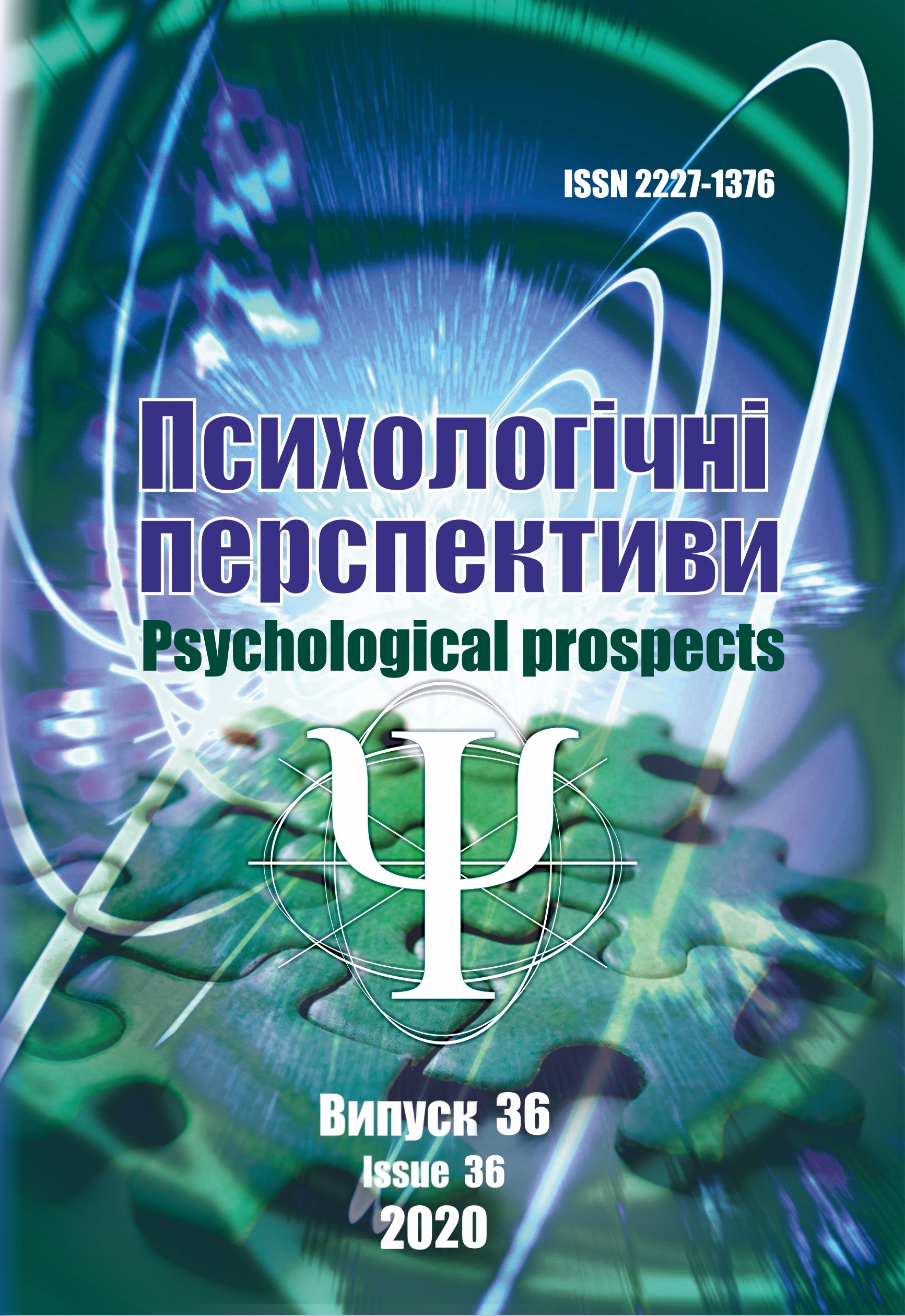Empirical referents of professionals` emotional safety
DOI:
https://doi.org/10.29038/2227-1376-2020-36-159-173Keywords:
personal safety, professional activity, propensity to stress, self-esteem, basic emotions, professional burnoutAbstract
Purpose. The article proposes to determine the place of emotional safety in the structure of professional security of the individual, as well as empirical reviewers of emotional safety. An important task is to identify the links between the general emotional background and the tendency to stress with self-esteem and burnout on three scales: emotional exhaustion, depersonalization and reduction of personal achievements; we assume that the emotional safety of the individual is related to the specifics of professional activities: working with people or with documents, management activities. Methods. In order to study the psychological features of the manifestation of emotional safety of the individual, including such empirical referents as stress, emotional exhaustion, depersonalization, reduction of professional achievements, expression of basic emotions and self-esteem, we used the following psychodiagnostic techniques: "Determining the degree of stress" by E. Tarasov); "Professional burnout" (by K. Maslach, S. Jackson in the adaptation of E. Vodopyanova); "Scale of differential emotions" (according to K. Izard); "Determining the level of self-esteem" (according to G. Kazantseva). Results. The emotional safety of a professional is seen as a sense of confidence in possession of internal psychological resources to confront the threats and dangers associated with professional activities. On the one hand, the emotional safety of a professional is supported by internal psychological resources, and on the other hand, a safe environment and trust in the organization. The propensity to stress, emotional background, level of burnout and self-esteem can hypothetically be the empirical referents that will identify the presence or absence of these resources. The results of a study aimed at examining the relationship between stress propensity and general emotional background with the level of self-esteem and burnout are presented. It is proved that the state of emotional safety is associated not so much with the psychological characteristics of the subjects, but with the specifics of the leading professional activity: working with documents, working with people, mixed form (people and documents), as well as leadership. Conclusions. There are significant statistical relationships between indicators of basic emotions and indicators of burnout (emotional exhaustion, depersonalization, reduction of professional achievements) and the level of self-esteem and between indicators of burnout and stress and self-esteem of employees. Further study of the phenomenon of emotional safety of the professional's personality is seen in the context of the organizational environment and interpersonal interaction of the organization's staff. An important task and challenge for organizational psychologists today is to find useful tools and programs to ensure the emotional stability and safety of staff in the workplace, which is certainly a promising area of further research.References
Bar-Tal, D., & Jacobson, D. (1998). A psychological perspective on security. Applied Psychology: An International Review, 47(1), 59–71. DOI: https://doi.org/10.1111/j.1464-0597.1998.tb00013.x
Blatz W.E. (1966). Human security: Some reflections. Toronto: University of Toronto Press.
Christopher J. Collins and Ken G. Smith (2006). Knowledge Exchange and Combination: The Role of Human Resource Practices in the Performance of High-Technology Firms. AMJ, 49, 544-560, DOI: https://doi.org/10.5465/amj.2006.21794671
Davies P., Cummings E.M. (1994). Marital conflict and child adjustment: An emotional security hypothesis. Psychological Bulletin. P. 116, 387–411.
Edmondson A. (1999). Psychological safety and learning behavior in work teams. Administrative science quarterly, 44(2), 350-383.
Edmondson A. C., & Lei, Z. (2014). Psychological safety: The history, renaissance, and future of an interpersonal construct. Annual Review of Organizational Psychology and Organizational Behavior. 1(1), 23-43. DOI: https://doi.org/10.1146/annurev-orgpsych-031413-091305
Erikson, E. H. (1968). Identity: Youth and crisis. New York: Norton.
H. Leroy, B. Dierynck, F. Anseel and T. Simons (2012). Behavioral integrity for safety, priority of safety, psychological safety, and patient safety: A team-level study. Journal of Applied Psychology, 97(6), 1273–1281.
Little M., Kobak R. (2003). Emotional security with teachers and children's stress reactivity: A comparison of special-education and regular-education classrooms. Journal of Clinical Child & Adolescent Psychology. P. 32, 127–138.
M. Baer and M. Frese (2003). Innovation is not enough: Climates for initiative and psychological safety, process innovations, and firm performance. Journal of Organizational Behavior, 24(1), 45–68.
May D.R. (2004). The psychology condition of meanіngfulness, safety and availability and the engagement of the human spirit at work. Journal of Occupational and Organizational Psychology. №77, 11–37.
Mikulincer M. (1998). The relationship between adult attachment styles andemotional and cognitive reactions to stressful events. In J.A.Simpson & W.S.Rholes (Eds.). Attachment Theory and Close Relationships. New York: Guilford Press, 143–165.
R. Law, M. Dollard, M. Tuckey and C. Dormann (2011). Psychosocial safety climate as a lead indicator of workplace bullying and harassment, job resources, psychological health and employee engagement. Accident Analysis & Prevention, 43(5), 1782–1793.
Toffler A. (1965). The Future as a Way of Life. Horizon magazine, Vol. VII, Num. 3.
Ahuzumtsian R.V. (2009). Psykholohycheskye aspekty bezopasnosty lychnosty. [Psychological aspects of personal safety] Vestnyk praktycheskoi psykholohyy obrazovanyia - Bulletin of practical educational psychology, 2 (19), 40–44 [in Russian].
Bek U. (2000). Obshchestvo ryska. Na puty k druhomu modern [Risk society. On the way to another modernity]. M.: Prohress-Tradytsyia [in Russian].
Blynova O.Y., Kalenchuk V.O. (2018). Osobystisni chynnyky psykholohichnoi bezpeky studentiv zakladiv vyshchoi osvity [Individual factors of psychological safety of the students of higher education institutions]. Naukovyi visnyk KhDU Seriia Psykholohichni nauky - Scientific Bulletin of KSU Series Psychological Sciences, 5, 154-160 [in Ukrainian].
Zaks L.A. (2012). Chelovek v uslovyiakh kompleksnykh uhroz lychnoi bezopasnosty [A person in conditions of complex threats to personal safety]. Nauka y sovremennost - Science and modernity, 18, 142–147 [in Russian].
Zotova O.Y. (2011). Sotsyalno-psykholohycheskaia bezopasnost lychnosty [Socio-psychological security of the individual]. Extended abstract of Doctor’s thesis. M. [in Russian].
Lazorko O.V. (2016). Psykholohiia profesiinoi bezpeky osobystosti [Psychology of professional security of the individual]. Lutsk : Vezha-Druk [in Ukrainian].
Prykhodko I. I. (2013). Zasady psykholohichnoi bezpeky personalu ekstremalnykh vydiv diialnosti [Principles of psychological safety of personnel of extreme activities]. Kh. : Akad. VV MVS Ukrainy [in Ukrainian].
Downloads
Published
Issue
Section
License
Copyright (c) 2020 Lazorko Olha, Shevtsova Tetiana

This work is licensed under a Creative Commons Attribution-NonCommercial 4.0 International License.






